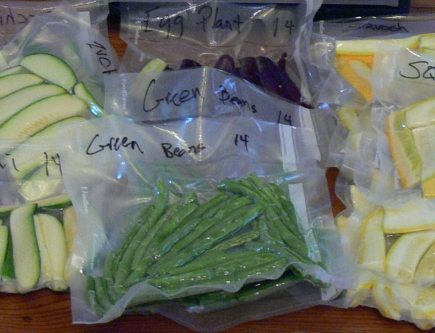This article was written by Mike Nivato. It is republished from Garden Culture Magazine, Issue 4, where it appeared under the title, “Sealing In Freshness”.
Every time I harvest something, there’s usually more that I can eat in one go, or keep fresh. The daunting question then is what to do with it. Put it in a jar? Freeze it? Give it away? Dry it? Well, there’s another option I’d like to add to that list, vacuum sealing.
Advantages of Vacuum Sealing
Vacuum sealed foods will last longer than other storage methods, aside from canning. Regular plastic wrap, foil, zip-lock bags, and even airtight containers cannot preserve foods as well as vacuum sealing.
Besides lasting longer, they also taste fresher, and the structure of foods (for example, vegetables) feels better in your mouth than with other storage methods. You can save money and time with this preserving method because the food you grow will not go to waste. To realize just how possible this is, you need to understand the science behind vacuum sealing.
Why Vacuum Sealing Works Better

Food ripens as a result of oxygen exposure. Fruits, herbs, vegetables, and meats will begin to spoil after a certain amount of time because they’ve been exposed to the air. Often mold and bacteria will develop, leaving the food undesirable, because of the change in odor, color, and texture of it. Sometimes bacteria can develop without air, but mold does not develop without a healthy supply of oxygen.
When you vacuum seal your food, what you are actually doing is removing the air and oxygen from the bag. Without air, mold and some bacteria are unable to live or grow. Over time, however, the food you store might spoil if it is not refrigerated or frozen.
If you vacuum seal your food while it is very fresh, and store it appropriately, it will last longer than if you had used another storage method.
How Does Vacuum Sealing Work?
Actually, it’s pretty easily explained. By sucking out all the air, the vacuum sealer creates a vacuum, and then it seals it. Pretty simple huh? It vacuums, and it seals. The technology behind it is a little bit more complex.
There are 2 types of vacuum sealers on the market, the non-chambered and the chamber vacuum sealer. Since the chamber vacuum sealer is pretty expensive, it’s almost solely used by professionals like chefs, and the food industry. So, for this article, I’ll focus on the non-chambered version.

The biggest difference in usage is that non-chamber units cannot vacuum seal liquids. There’s a way around that limitation. To package liquid items, first, freeze them into a solid form. They can then be vacuum packaged and stored in the freezer to maintain the frozen state.
Vacuum Sealing is Easy!
It just so happens that I got sent a vacuum sealer from our friends at SousVide Supreme while researching another article on vacuum cooking, which you can read in this issue. Some brands of vacuum sealers for home use aren’t that great, but I can definitely recommend that
one since we’ve used it extensively over the last month.
You don’t need to become an expert to use a vacuum sealer. It’s as simple as placing your produce in the bag, place the open side of the bag in the machine, and press the vacuum/seal button.
As a farmer with 20 years of experience, I can attest to the importance of preserving food freshness. Vacuum sealing is one of the best methods to ensure your produce stays fresh for a long time. This article on Garden Culture Magazine offers great insights on how to vacuum seal food.
But preserving food freshness isn’t just about vacuum sealing. It’s also about preserving the nutritional value of your food. That’s why I highly recommend “The Lost Superfoods” book. It offers valuable information on how to grow, harvest, and preserve ancient and forgotten superfoods that are packed with nutrients. Check it out at http://www.superfoods.recensorium.com